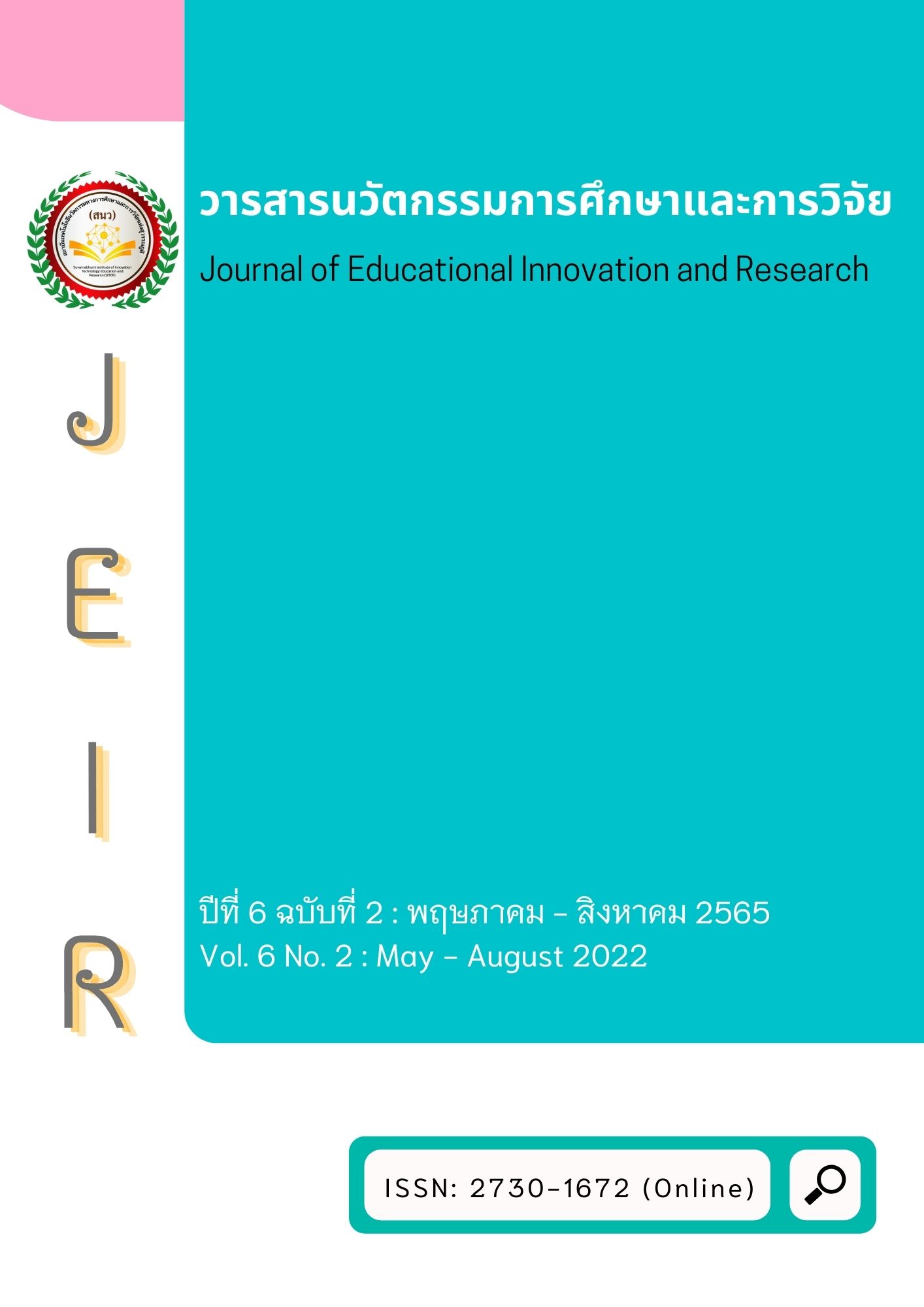การพัฒนารูปแบบกิจกรรมการสร้างเสริมสุขภาพและการดูแลเท้า ของผู้สูงอายุโรคเบาหวาน ของโรงพยาบาลส่งเสริมสุขภาพตำบลปทุม
Main Article Content
บทคัดย่อ
การวิจัยและพัฒนานี้มีวัตถุประสงค์ 1) ศึกษาสภาพปัญหาและความต้องการกิจกรรมสร้างเสริมสุขภาพของผู้สูงอายุโรคเบาหวาน 2) พัฒนารูปแบบกิจกรรมการสร้างเสริมสุขภาพและการดูแลเท้าของผู้สูงอายุโรคเบาหวาน โดยใช้กรอบแนวคิดพฤติกรรมส่งเสริมสุขภาพของเพนเดอร์และแนวคิดการประเมินแบบเสริมพลังของเฟตเตอร์แมน กลุ่มตัวอย่างเป็นผู้สูงอายุ 60 ปีขึ้นไปที่มีประวัติป่วยเป็นโรคเบาหวาน จำนวน 102 ราย โดยคัดเลือกแบบเจาะจง เครื่องมือที่ใช้ในการวิจัย 1) ใช้แนวทางการสนทนากลุ่มศึกษาสภาพปัญหาและความต้องการกิจกรรมสร้างเสริมสุขภาพและพัฒนารูปแบบ 2)ทดลองใช้กิจกรรมสร้างเสริมสุขภาพ โดยใช้แบบสอบถามพฤติกรรมการดูแลเท้า หาความเชื่อมั่นของเครื่องมือด้วยวิธีสัมประสิทธิ์แอลฟาของครอนบาค ได้ค่าความเชื่อมั่นเท่ากับ .802 และแบบประเมินสภาวะเท้าของผู้ป่วยเบาหวาน
ได้ค่าความเชื่อมั่นเท่ากับ .922 วิเคราะห์ข้อมูลโดยใช้การแจกแจงความถี่ ร้อยละ ค่าคะแนนเฉลี่ยและส่วนเบี่ยงเบนมาตรฐาน และวิเคราะห์ข้อมูลเชิงคุณภาพโดยใช้การวิเคราะห์ข้อมูลเชิงเนื้อหา ผลการวิจัยพบว่าสภาพปัญหาในการจัดกิจกรรมสร้างเสริมสุขภาพของผู้สูงอายุโรคเบาหวาน ยังไม่มีรูปแบบที่เหมาะสมเฉพาะรายบุคคลหรือเฉพาะกลุ่มผู้สูงอายุ กลุ่มตัวอย่างต้องการการจัดกิจกรรมที่เป็นรูปธรรม ชัดเจนเฉพาะรายบุคคลและมีความต่อเนื่อง รูปแบบกิจกรรมการสร้างเสริมสุขภาพ ได้แก่ 1) การประเมินพฤติกรรมการดูแลเท้า/การประเมินสภาวะเท้า 2) การให้ความรู้ 3) การสอนสาธิต 4) การได้รับคู่มือ /เอกสารแผ่นพับด้านอาหาร ออกกำลังกาย การบริหารเท้า หลังการใช้รูปแบบกิจกรรมการสร้างเสริมสุขภาพและการดูแลเท้า พบว่า ภาพรวมการจัดกิจกรรมสร้างเสริมสุขภาพมีค่าเฉลี่ยความพึงพอใจอยู่ในระดับมาก ( = 3.94, SD = 0.65) โดยมีค่าเฉลี่ยความพึงพอใจสูงที่สุดได้แก่ ด้านคู่มือ/ เอกสารแผ่นพับ โดยมีค่าเฉลี่ยระดับมาก ( = 4.10, SD=0.43) งานวิจัยครั้งนี้สามารถนำไปวางแผน ส่งเสริม สนับสนุนและพัฒนากระบวนการให้ความรู้แก่ผู้สูงอายุโรคเบาหวาน เพื่อให้มีพฤติกรรมการดูแลเท้าที่ถูกต้อง เหมาะสม ลดภาวะแทรกซ้อน โดยกิจกรรมควรจัดให้สอดคล้องกับแบบแผนการดำเนินชีวิตตามบริบททางสังคมของผู้สูงอายุเพื่อให้เกิดพฤติกรรมการดูแลเท้าที่ดียิ่งขึ้น
Article Details

อนุญาตภายใต้เงื่อนไข Creative Commons Attribution-NonCommercial-NoDerivatives 4.0 International License.
เอกสารอ้างอิง
จิรพรรณ ผิวนวลและ ปทุม เนตรินทร์. (2561). พฤติกรรมการดูแลตนเองของผู้ป่วยเบาหวานที่ควบคุมระดับน้ำตาลในเลือดไม่ได้ โรงพยาบาลส่งเสริมสุขภาพตำบลบางแก้ว ในตำบลบางแก้ว อำเภอ
ละอุ่น จังหวัดระนอง. วารสารวิทยาลัยพยาบาลพระจอมเกล้า จังหวัดเพชรบุรี,1(2), 46-61.
ฐิติชญา ฉลาดล้น สุธีพร มูลศาสตร์ วรรณรัตน์ ลาวัง. (2561). การพัฒนารูปแบบกิจกรรมสร้างเสริมสุขภาพสำหรับผู้สูงอายุในชมรมผู้สูงอายุคลังปัญญา อำเภอบ้านโป่ง จังหวัดราชบุรี. วารสารพยาบาลกระทราวงสาธารณสุข, 27(2),. 154-167.
มณกร ศรีแป๊ะบัว. (2557). ผลของโปรแกรมการพยาบาลระบบสนับสนุนและให้ความรู้ต่อการรับรู้ความสามารถในการดูแลเท้าและพฤติกรรมการดูแลเท้าในผู้ป่วยเบาหวาน กลุ่มเสี่ยงต่อการเกิด
แผลที่เท้า (วิทยานิพนธ์พยาบาลศาสตรมหาบัณฑิต). มหาวิทยาลัยบูรพา.
วิชัย เอกพลากร. (2564). การสำรวจสุขภาพประชาชนไทยโดยการตรวจร่างกาย ครั้งที่ 6 พ.ศ. 2562- 2563. กรุงเทพฯ: คณะแพทยศาสตร์โรงพยาบาลรามาธิบดี มหาวิทยาลัยมหิดล.
สมาคมโรคเบาหวานแห่งประเทศไทย. (2560). แนวทางเวชปฏิบัติสำหรับโรคเบาหวาน 2560. สืบค้นเมื่อ 5 มิถุนายน 2564, จาก http://www.Thaiendocrine.org/2018
สำนักงานคณะกรรมการพัฒนาเศรษฐกิจและสังคมแห่งชาติ. (2563). แผนยุทธศาสตร์สุขภาพดีวิถีไทย พ.ศ. 2554-2563. กรุงเทพฯ: กระทรวงสาธารณสุข.
อโนทัย ผลิตนนท์เกียรติ. (2560). ปัจจัยที่มีความสัมพันธ์กับการเกิดแผลที่เท้าของผู้ป่วยโรคเบาหวาน ในโรงพยาบาลของเครือข่ายหน่วยบริการปฐมภูมิ อำเภอพระประแดง จังหวัดสมุทรปราการ. วารสารวิชาการสมาคมสถาบันอุดมศึกษาเอกชนแห่งประเทศไทย ฉบับวิทยาศาสตร์และเทคโนโลยี, 6(1), 56-67.
อริสรา สุขวัจนี. (2558). แนวปฏิบัติเพื่อป้องกันและดูแลการเกิดแผลที่เท้าและการถูกตัดขาหรือเท้าในผู้ป่วยเบาหวาน. วารสารการแพทย์และวิทยาศาสตร์สุขภาพ, 22(2), 99-107.
David,M.F. (2005). Conceptualizing Empowerment in Terms of Sequential Time and Social Space. in: Empowerment Evaluation Principles in Practice. New York: The Guilford Press.
World Health Organization. (2008). Preventive of diabetes mellitus. Geneva: World Health Organization.


